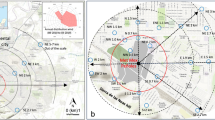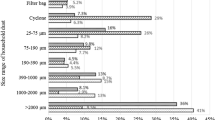Abstract
Residents in older homes may experience increased lead (Pb) exposures due to release of lead from interior paints manufactured in past decades, especially pre-1960s. The objective of the study was to determine the speciation of Pb in settled dust from an urban home built during WWII. X-ray absorption near-edge structure (XANES) and micro-X-ray diffraction (XRD) analyses were performed on samples of paint (380–2,920 mg Pb kg−1) and dust (200–1,000 mg Pb kg−1) collected prior to renovation. All dust samples exhibited a Pb XANES signature similar to that of Pb found in paint. Bulk XANES and micro-XRD identified Pb species commonly found as white paint pigments (Pb oxide, Pb sulfate, and Pb carbonate) as well as rutile, a titanium-based pigment, in the <150 μm house dust samples. In the dust fraction <36 μm, half of the Pb was associated with the Fe-oxyhydroxides, suggesting additional contribution of outdoor sources to Pb in the finer dust. These results confirm that old paints still contribute to Pb in the settled dust for this 65-year-old home. The Pb speciation also provided a clearer understanding of the Pb bioaccessibility: Pb carbonate > Pb oxide > Pb sulfate. This study underscores the importance of taking precautions to minimize exposures to Pb in house dust, especially in homes where old paint is exposed due to renovations or deterioration of painted surfaces.




Similar content being viewed by others
References
Abt, E., Suh, H. H., Allen, G., & Koutrakis, P. (2000). Characterization of indoor particle sources: A study conducted in the metropolitan Boston area. Environmental Health Perspectives, 108(1), 35–44.
Adgate, J. L., Rhoads, G. G., & Lioy, P. J. (1998a). The use of isotope ratios to apportion sources of lead in Jersey City, NJ, house dust wipe samples. Science of the Total Environment, 221, 171–180.
Adgate, J. L., Willis, R. D., Buckley, T. J., Chow, J. C., Watson, J. G., Rhoads, G. G., et al. (1998b). Chemical mass balance source apportionment of lead in house dust. Environmental Science and Technology, 32, 108–114.
Allott, R. W., Kelly, M., & Hewitt, C. N. (1992). Behavior of urban dust contaminated by Chernobyl fallout: Environmental half-lives and transfer coefficients. Environmental Science and Technology, 26(11), 2142–2147.
APac Chemical Corporation. (2002). Citric acid. General product information. http://www.apacchemical.com/citricacidprint.htm. Verified 16 December 2009.
Barrett, J. E. S., Taylor, K. G., Hudson-Edwards, K. A., & Charnock, J. M. (2010). Solid-phase speciation of Pb in urban road dust sediment: a XANES and EXAFS study. Environmental Science and Technology, 44, 2940–2946.
Butte, W., & Heinzow, B. (2002). Pollutants in house dust as indicators of indoor contamination. Reviews of Environmental Contamination and Toxicology, 175, 1–46.
Canada Mortgage and Housing Corporation. (2009). Lead in older homes. Website from Government of Canada. http://www.cmhc-schl.gc.ca/en/co/maho/yohoyohe/inaiqu/inaiqu_007.cfm. Verified February 9, 2010.
Casteel, S. W., Weis, C. P., Henningsen, G. M., & Brattin, W. J. (2006). Estimation of relative bioavailability of lead in soil and soil-like materials using young swine. Environmental Health Perspectives, 118, 1162–1171.
Corbeil, M.-C., & Robinet, L. (2002). X-ray powder diffraction data for selected metal soaps. Powder Diffraction, 17(1), 52–60.
Culbard, E. B., Thorton, I., Watt, J., Wheatley, M., Moorcroft, S., & Thompson, M. (1988). Metal contamination in British urban dusts and soils. Journal of Environment Quality, 17, 226–234.
Encyclopædia Britannica. (2009). Anhydrite In: Encyclopædia Britannica Online. Retrieved April 15, 2009 from Encyclopædia Britannica Online: http://www.britannica.com/EDchecked/topic/25417/anhydrite.
Funasaka, K., Tojo, T., Katahira, K., Shinya, M., Miyazaki, T., Kamiura, T., et al. (2008). Detection of Pb L-III edge XANES spectra of urban atmospheric particles combined with simple acid extraction. Science of the Total Environment, 403, 230–234.
Godelitsas, A., Astilleros, J. M., Hallam, K., Harissopoulos, S., & Putnis, A. (2003). Interaction of calcium carbonates with lead in aqueous solutions. Environmental Science and Technology, 37, 3351–3360.
Gooch, J. W. (1993). Lead-based paint handbook. New York: Plenum Press.
Hall, G. S., & Tinklenberg, J. (2003). Determination of Ti, Zn, and Pb in lead-based house paints by EDXRF. Journal of Analytical Atomic Spectrometry, 18, 775–778.
Hammersley, A. P. (1998). FIT2D V10.3 reference manual V4.0. European synchrotron research facility. Paper ESRF98-HA0IT: Grenoble, France.
Health Canada. (2007). Lead and Health. Health Canada publication 4462, ISBN 978-0-662-44815-0. Available on website. http://www.hc-sc.gc.ca/ewh-semt/pubs/contaminants/lead-plomb-eng.php. Verified May 3, 2010.
Hunt, A., Johnson, D. L., & Griffith, D. A. (2006). Mass transfer of soil indoors by track-in on footwear. Science of the Total Environment, 370, 360–371.
Kim, N., & Fergusson, J. (1993). Concentrations and sources of cadmium, copper, lead, and zinc in house dust in Christchurch, New Zealand. Science of the Total Environment, 138, 1–21.
Lanphear, B. P., Hornung, R., Ho, M., Howard, C. R., Eberle, S., & Knauf, K. (2002). Environmental lead exposure during early childhood. Journal of Pediatrics, 40, 40–47.
Lattaud, K., Vilminot, S., Hirlimann, C., Parant, H., Schoelkopf, J., & Gane, P. (2006). Index of refraction enhancement of calcite particles coated with zinc carbonate. Solid State Sciences, 8, 1222–1228.
MacLean, L. C. W., Beauchemin S., & Rasmussen P. E. (2010). Application of synchrotron X-ray techniques for the determination of metal speciation in (house) dust particles. In C. L. S. Wiseman & F. Zereini (Eds.), Urban airborne particulate matter: Origins, chemistry, fate and health impacts (pp. 193–216). Springer-Verlag, Berlin.
Manceau, A., Boisset, M. C., Sarret, G., Hazemann, R. L., Mench, M., Cambier, P., et al. (1996). Direct determination of lead speciation in contaminated soils by EXAFS spectroscopy. Environmental Science and Technology, 30, 1540–1552.
Morin, G., Ostergren, J. D., Juillot, F., Ildefonse, P., Calas, G., & Brown, G. E. (1999). XAFS determination of the chemical form of lead in smelter-contaminated soils and mine tailings: Importance of adsorption processes. American Mineralogist, 84, 420–434.
Pingitore, N. E., Jr, Clague, J., Amaya, M. A., Maciejewska, B., & Reynoso, J. J. (2009). Urban airborne lead: X-ray absorption spectroscopy establishes soil as dominant source. PLoS One, 4, e5019.
Plater, J. M., de Silva, B., Gelbrich, T., Hursthouse, M. B., Higgitt, C. L., & Saunders, D. R. (2003). The characterization of lead fatty acid soaps in ‘protrusions’ in aged traditional oil paint. Polyhedron, 22, 3171–3179.
Rasmussen, P. E. (2004a). Elements and their compounds in indoor environments. In E. Merian, M. Anke, M. Ihnat, et al. (Eds.), Elements and their compounds in the environment (pp. 215–234). Weinheim, Germany: Wiley-VCH.
Rasmussen, P. E. (2004b). Can metal concentrations in indoor dust be predicted from soil geochemistry? Canadian Journal of Analytical Sciences and Spectroscopy, 49, 166–174.
Rasmussen, P. E., Beauchemin, S., Nugent, M., Dugandzic, R., Lanouette, M., & Chénier, M. (2008). Influence of matrix composition on bioaccessible copper, zinc and nickel in urban residential dust and soil. Human and Ecological Risk Assessment, 14, 351–371.
Rasmussen, P. E., Subramanian, K. S., & Jessiman, B. J. (2001). A multi-element profile of housedust in relation to exterior dust and soils in the city of Ottawa, Canada. Science of the Total Environment, 267, 125–140.
Ravel, B., & Newville, M. (2005). ATHENA, ARTEMIS, HEPHAESTUS: data analysis for X-ray absorption spectroscopy using IFEFFIT. Journal of Synchrotron Radiation, 12, 537–541.
Schwertmann, U., & Cornell, R. M. (1991). Iron oxides in the laboratory. Weinheim, Germany: VCH Publishers.
Terzano, R., Spagnuolo, M., Vekemans, B., de Nolf, W., Janssens, K., Falkenberg, G., et al. (2007). Assessing the origin and fate of Cr, Ni, Cu, Pb, and V in industrial polluted soil by combined microspectroscopic techniques and bulk extraction methods. Environmental Science and Technology, 41, 6762–6769.
Utsunomiya, S., Jensen, K. A., Keeler, G. J., & Ewing, R. C. (2004). Direct identification of trace metals in fine and ultrafine particles in the Detroit urban atmosphere. Environmental Science and Technology, 38, 2289–2297.
Van Alphen, M. (1998). Paint film components. National environmental health forum monographs, General series no. 2, Glenelg Press, Australia.
Acknowledgments
Funding for this project comes from Health Canada’s Chemicals Management Plan (ref. no. CRRS/SDRC: 4500177216). Part if this research was conducted at the beamline X-11A at the National Synchrotron Light Source (NY; contract DE-AC02-98CH10886) and at GeoSoilEnviroCARS (Sector 13), Advanced Photon Source (Chicago; contract DE-AC02-06CH11357), which are both supported by the US Department of Energy. The authors are very grateful to Dr. Kumi Pandya (NSLS), Dr. Matt Newville, and Nancy Lazarz (APS) for their help during the experimental runs. Sincere thanks are extended to Marc Chénier and Christine Levesque (Health Canada), and to Dr. John Wilson and Ted MacKinnon (Natural Resources Canada) for laboratory assistance, ICP-MS and XRD characterization. The constructive comments of Dr. Mark Richardson and Sarah Sheffield (Health Canada), and Dr. Allen Pratt (Natural Resources Canada) on an earlier version of the manuscript were greatly appreciated.
Author information
Authors and Affiliations
Corresponding author
Electronic supplementary material
Below is the link to the electronic supplementary material.
Rights and permissions
About this article
Cite this article
Beauchemin, S., MacLean, L.C.W. & Rasmussen, P.E. Lead speciation in indoor dust: a case study to assess old paint contribution in a Canadian urban house. Environ Geochem Health 33, 343–352 (2011). https://doi.org/10.1007/s10653-011-9380-8
Received:
Accepted:
Published:
Issue Date:
DOI: https://doi.org/10.1007/s10653-011-9380-8




